| Columns Retired Columns & Blogs |
6 to 7 bit SNR and 9 WPC at 5% THD for $16,000 to $20,000 ....... Wonder how DSD 1024 and PCM 32/768 sound like with this amp? :-) .........
I measured the Air Tight ATM-300R with my Audio Precision SYS2722 system (see the January 2008 "As We See It"). Before doing any testing, I checked the ATM-300R's front-panel meter to ensure that the bias was correctly set for the two 300B output tubes.
The Air Tight's maximum voltage gain into 8 ohms from its High (8 ohm) output-transformer tap, which was how Art Dudley listened to the amplifier, was a high 29.5dB; from the Low (4 ohm tap) it measured 26.9dB. Both output taps preserved absolute polarity (ie, were non-inverting). The input impedance was a usefully high 78.5k ohms at low and middle frequencies, dropping to a still-high 54k ohms at 20kHz. The output impedance from the 4 ohm tap was low for a single-ended tube design, at 0.84 ohm at 1kHz, rising to 1 ohm at 20Hz and 20kHz. From the 8 ohm tap, the output impedance was 1.2 ohms at 1kHz and 2 ohms at 20Hz and 20kHz, these values still low for this kind of amplifier. As a result, the response with our standard simulated loudspeaker varied by ±0.8dB (fig.1, gray trace).
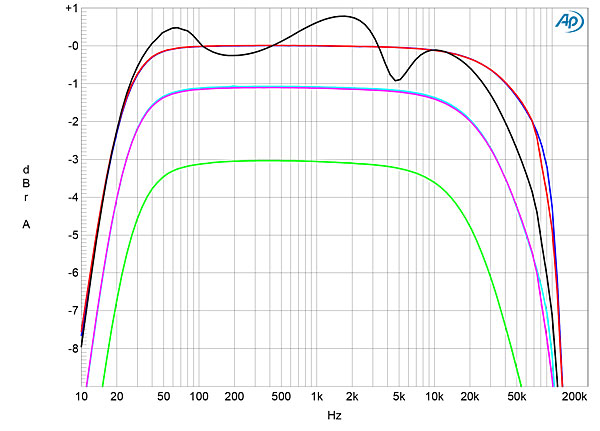
Fig.1 shows that the ATM-300R's audioband response is flat up to 10kHz, with a small amount of rolloff in the top octave reaching –0.3dB at 20kHz into 8 ohms (blue and red traces), but –1.8dB into 2 ohms (green). The top-octave rolloff was lower from the 4 ohm tap, but now a low-level peak was evident around 150kHz, this associated with a small amount of overshoot or ringing with a 10kHz squarewave from this tap (fig.2). A 1kHz squarewave was reproduced with flat tops and bottoms from both taps (fig.3), suggesting excellent output-transformer design.
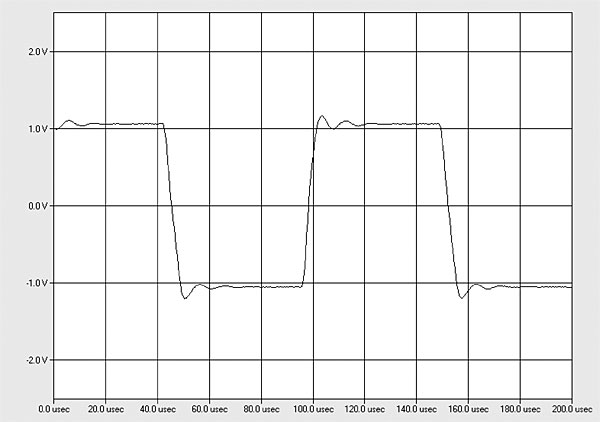
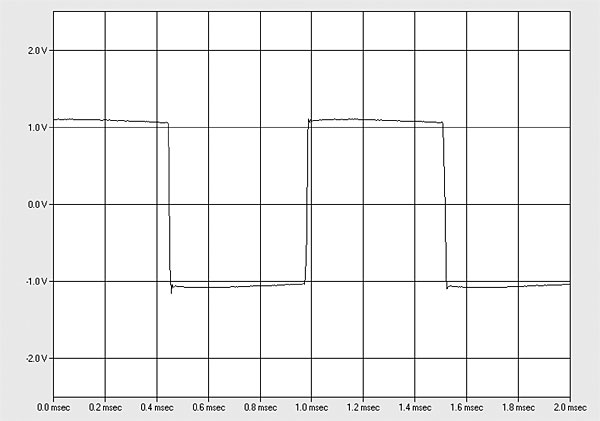
The ATM-300R's channel separation, measured at a level close to clipping into 8 ohms, was 87dB L–R and 77dB R–L at 2kHz, but these decreased at the frequency extremes (fig.4). The reduction at high frequencies is presumably due to capacitive coupling between the channels somewhere in the circuit; at low frequencies, it suggests an increasing power-supply impedance as the frequency drops. The wideband, unweighted signal/noise ratio, ref. 2.83V and measured with the input shorted to ground but the level controls set to their maximum, was a moderate 71dB in the left channel and 67dB in the right. These ratios improved slightly, to 71.3dB, when the measurement bandwidth was restricted to the audioband, and to 87.5dB when A-weighted. Spectral analysis of the Air Tight's noise floor (fig.5) revealed spuriae at 60Hz and its odd- and even-order harmonics. All of these spuriae are sufficiently low in level that they will not be audible as hum; also notable in this graph is the absence of the low-frequency random noise that is often present with tube designs.
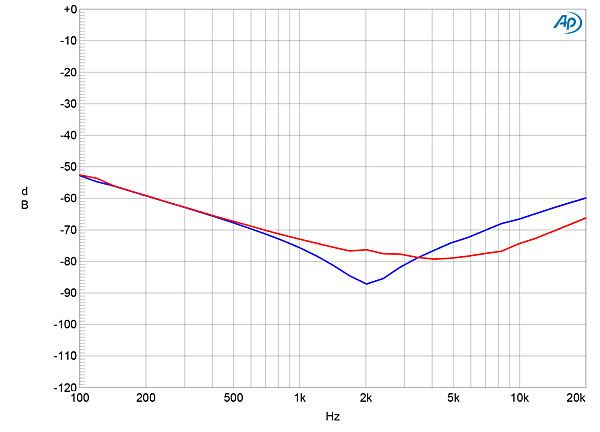

The ATM-300R is specified as being able to deliver 8Wpc (9.03dBW), presumably with the load matched to the nominal output-transformer tap. With "clipping" defined as when the THD+noise reaches 1%, fig.6, taken from the 8 ohm tap with both channels driven, indicates that the Air Tight clipped at 3.65Wpc into 8 ohms (5.6dBW). Relaxing the definition of clipping to 3% THD+N, the Air Tight clipped at 9Wpc (9.54dBW). Into 4 ohms (fig.7), the ATM-300R's 8 ohm tap delivered 4.5Wpc (6.5dBW) at 3% THD+N. From its 4 ohm tap, the ATM-300R clipped (3% THD+N) at 9W into 8 ohms (fig.8) and 4 ohms (not shown). Figs. 5–8 reveal that the distortion rises linearly as the power increases, which is typical for an amplifier with a single-ended output stage; however, the distortion at low powers is higher than that of the single-ended but solid-state First Watt SIT-3 reviewed elsewhere in this issue.
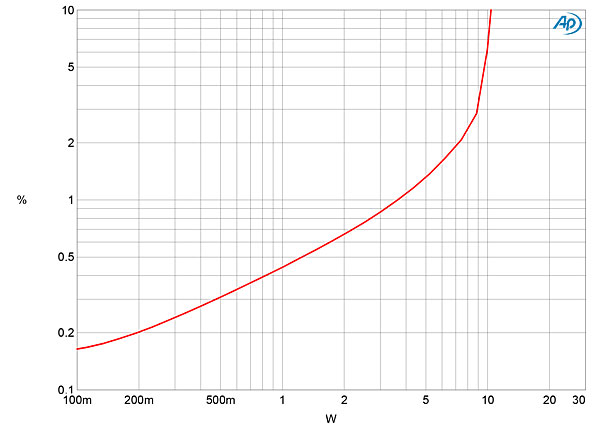
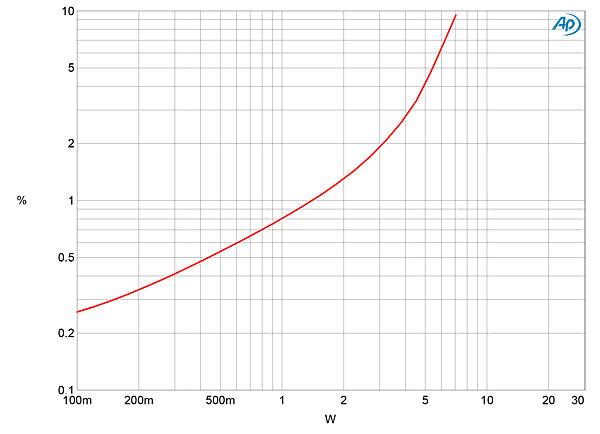
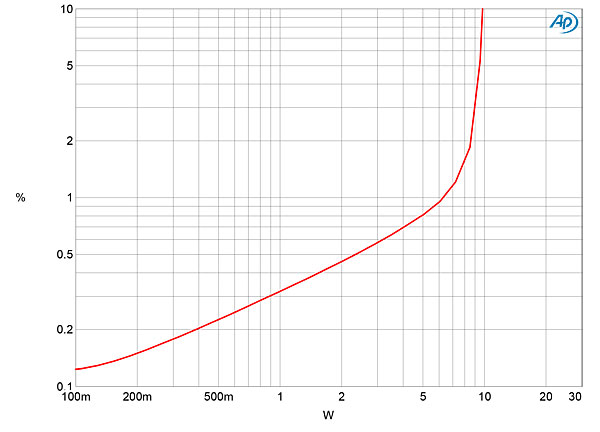
Like that First Watt amplifier, the Air Tight ATM-300R offered levels of distortion that remained relatively constant with frequency but that increased into lower impedances (fig.9). The rise in THD+N at low frequencies was small, which again suggests an excellent output transformer with a sufficiently hefty core. This graph was taken from the 8 ohm tap; distortion levels from the 4 ohm tap (fig.10) were just half those from the 8 ohm tap.
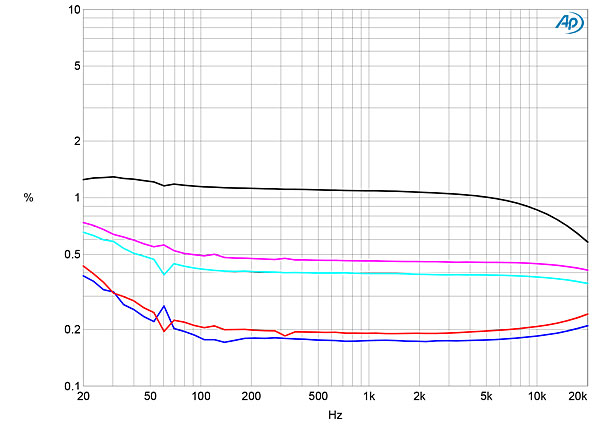

As with the First Watt SIT-3, the Air Tight's distortion was predominantly the sonically benign second harmonic, but this time in phase with the fundamental regarding the positive-going half cycles (fig.11). The third harmonic was around 22dB lower in level than the second harmonic (fig.12), but it both increased in level and got closer to the level of the second harmonic as the output stage was asked to deliver more current (fig.13). Tested with an equal mix of 19 and 20kHz tones at a low power into 8 ohms, the amplifier produced levels of higher-order intermodulation products that were relatively low (fig.14), though the second-order difference product lay close to –50dB (0.3%).
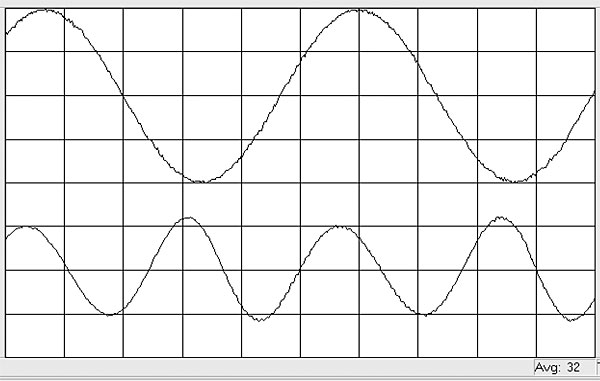
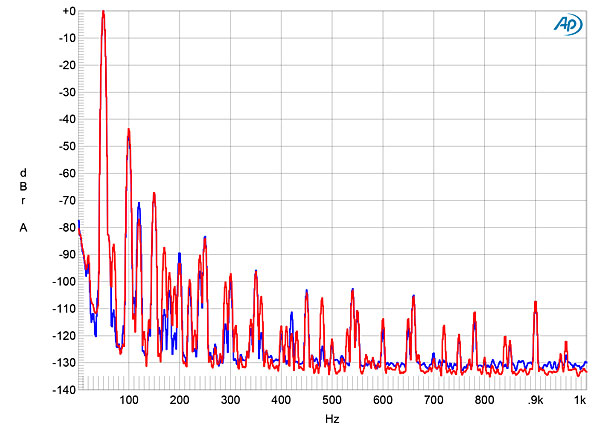
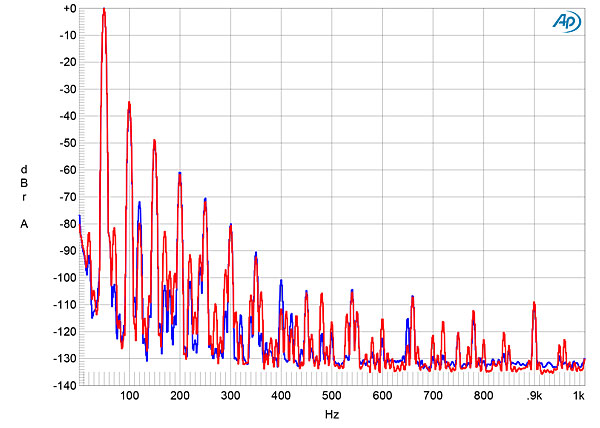
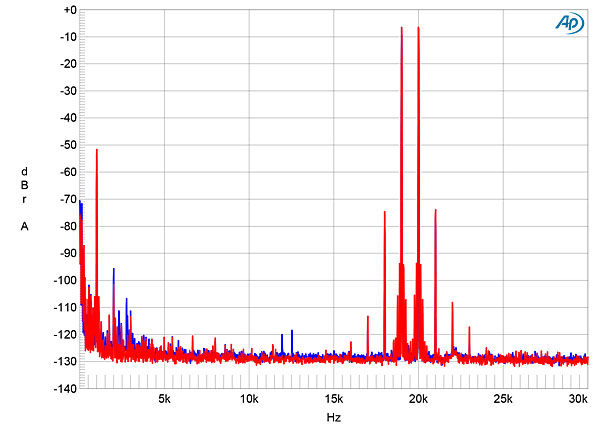
The relatively high level of second-harmonic distortion comes with the territory in an amplifier having a single-ended output stage. Otherwise, Air Tight's ATM-300R appears to be well engineered. But it does need to be used with a loudspeaker with an impedance that doesn't drop below 8 ohms, like the DeVore Fidelity Orangutan O/93 that AD used for his auditioning.—John Atkinson

6 to 7 bit SNR and 9 WPC at 5% THD for $16,000 to $20,000 ....... Wonder how DSD 1024 and PCM 32/768 sound like with this amp? :-) .........

I've been lucky enough to spend several hours listening to Tone of Music's ATM-300R that's loaded with the Takatsuki 300Bs, and driving a pair of O/96 Devores. The combination is brilliant, for sure.
But as an Altec Valencia 846A owner, I'd absolutely love to hear how the ATM-300R dances with the 16 ohm beasts.


Hi Art.
Great review and very wise to try the Takatzukis.
Electro Harmonix is not producing any worthwhile tubes and especially with Air Tight, it is mandatory to replace all tubes with the good stuff. You've been in there long enough to know what I´m talking about.
I´m an Air Tight user and people maybe wouldn't believe what happens if you do that until they heard it with their own ears. These amps are transformed. I replaced the EH 6L6 in my ATM-4 with NOS GE 6L6 and its night and days. Same with my preamps. So in the end you only really know what this amp is capable of, once you've done that.
Best wishes from Munich
Chris

But there is good art and bad art. The 'art' we are interested in is high fidelity, which means 'accuracy' by definition. This amp has high noise levels and high distortion, so it is not accurate and thus must be bad hi fi 'art'.
Thus it is of low quality. Anyone want to buy a couple of my low quality paintings? Only 20,000 dollars each.
(And as for reibradi's tube changing, I think Leonardo's Mona Lisa would be much improved by giving her a Rasta hairstyle. Why has that not been done?)
I make this post to indicate just how ridiculous much 'hi fi' has become and to illustrate how some people will fall for anything.
PS: I just found the Solti/Vienna Das Rheingold on Tidal and am listening to it as I write this. It sound very "glorious" via my
500 Dollar Chord Mojo, my 800 Dollar Yamaha AV receiver set on 'Pure Direct' for unmolested 2 channel stereo, and my 10,000 Dollar Tannoy Kensington speakers. (Which perhaps shows where my priorities lie, most low-cost modern transistor amplifiers being 'good'.)
Maybe it's the music, not the Air Tight amp. Perhaps Art should try the Air Tight on some Meat Loaf (large and pretentious, just like Wagner)
or Beyoncé and come back to us :)

In fact a decent smartphone with carefully designed audio section and a pair of nice n’ easy to drive headphones are more than adequate for any sane hifi listening. Battery-powered, minimal signal path, single driver configuration and all for audio purists plus a handy phone in case one still prefers the mighty Kensingtons.

In fact the Chord Mojo WILL drive the Kensingtons direct, though not to what you might call a 'comfortable' level.
Many years ago a respected British Audio engineer, Doug Self, the then chief designer for Cambridge Audio and frequent writer for the 'professional level' magazine Wireless World, coined the term "Blameless Amplifier".
He said the total level of all distortions, noise, etc, whether we fully understand their causes and effects or not, added together, should be reduced to such a low level that they are inaudible. Then they won't matter.
I suggest that 90% plus of amplifiers from a couple of hundred dollars up achieved this some years ago and continue to do so. But this Air Tight isn't one.
Further, I suggest that for all audio 'systems', the closer we get to 'high fidelity', the more they should all sound the same, as the general idea is to get as close to 'perfect reproduction' as possible and there being only one 'perfect'.
You don't need to spend 16,000 Dollars plus on this Air Tight as you can get 'inaccurate' for much less :)
As for phones, I have a couple of low-cost pairs. But until I find an orchestra/band/soloist that runs across the stage to stay dead in front of me whenever I turn my head I won't be buying any more :)

Self’s book is an indispensable classic for anyone interested in actual amplifier design regardless of whether or not one fully agrees with his highly opinionated audio views. True, modern amplifiers can easily meet most “inaudible” distortion requirements at considerably lower a cost than years before; however they still don’t sound similar enough as often as they should, though much like trophy “timepieces” and casual wristwatches this has absolutely nothing to do with any nominal price tag.

Some say Self's amplifiers sound 'bland'. I suggest they don't realise that most live music is blander than they believe :)
As for this Air Tight amp, I have nothing against SETs (we may think objectively but we rarely buy objectively) but I think it is poor value, even for 'subjective' reasons.
It doesn't have the prestige or mystique of a Kondo but at the same time it is considerably more expensive than most other 8 Watt SETs.
And the 300B is a poor choice of tube, even for a low powered SET. The 300B projects its strong 'colour' on all music, of whatever genre.
Incidentally, the most realistic reproduced music I have ever heard was at a disco with a stage about the size of a boxing ring and a Bose 901 at each corner. They shouldn't have worked at all as it was outdoors where the rear speaker units of the four 901s had nothing to reflect from. It was run by the local BBC radio station who presumably know exactly what they are doing :)

Hi
Sorry, I have to disagree to yr above statement. This is not "colour".
300B, particulary RCA 300B, sounds so lifelike, so elegant & so silky
that it blows away its triode peers.
I love its lifelike sound quality which makes any other tubes, triodes or pentodes/tetrodes alike, sound like an old bag dragging the feet.
When you have to chance like me to audition the USD125,000 a pair: KEGON of Audio Note Japan, 17W single-ended class A monblocks, you will appreciate why I said so.
Jack L.
Canada

Always a scathing read, certainly inspiring me to offer some weak'ish commentary and delighted to keep having the opportunity.
You MUST know, fully well, that 300b tubes have their own "sound".
I, personally, am fond of the el34 "sound" as are all "NORMAL" people because the el34 resonates with the Civilized Nature of today's polite Citizenry & Society.
I forgive you for not being part of the Low Power Amplifier Group and promise to continue to say only nice things about you, despite your angry Rants relating to all things regressive in Audio. ( I secretly smile as I read your observations, please don't tell anyone )
I admonish you because these low power people are a lovely group. There is no need to pummel them. Their Electronics range in Cost from $200 to $16,000ish. Their Loudspeakers are modest affairs.
Mr.Spacehound's gear begins ( and stays ) at the Elevated Chord levels, a Lofty position of technical superiority.
The far more important matter of Brexit is at hand.
I vote Corbin and staying the hell out of EU.
What Say You?
Tony in Michigan
ps. and Bernie Sanders, of course.
ps. 2 Look at that lovely point to point wiring, how could you not love the wires and capacitors and soldering tucked into that beautiful Chassis. This Amp is a Work of ART, dammit all, for gods sake!!!
ps.3 I'm gonna write something beautiful about this beautiful amp.

I have nothing against SETs, not even low power ones. But $16,000 is a bit much for 8 Watts.
I have not heard it but the Icon Audio 30SE integrated seems good value. Single ended using KT150 tubes, £2,300, 18 Watts/channel and looks almost as nice as a Kondo, even though the 'copper' top plate is in fact anodised aluminium :)
Icon Audio get good reviews in the UK and have been around for at least 20 years so they must have some merit.
The EU? I have doubts about getting 'political' on this site but let's hope JA allows it this one time. I stress that I am not making any 'party' or 'right or left' comments.
I am old enough to have been politically 'aware' since the mid 1960's. But I don't have any strong 'party political' views and have never been a member, or even a supporter, of any political party. I vote for the 'least bad' party regardless of 'right or left' depending on their recent record of when they were last in power. The UK is a democracy but it is not a 'representative' democracy. We vote for a 'list of promises' called a 'manifesto' that each party produces, but 'we the people' have no say about what is on those manifestos (which are mostly lies anyway).
Theresa May is the most utterly useless PM we have ever had in all that time. She is rigid and unbending, has 'consultations' which are mere dummies as she listens to nobody but herself, and her new 'Plan B' is identical to her original, which has already been accepted by the EU who have said no less than three times that they will accept no other 'deal' unless it is 'closer to the EU', such as a full customs union. But her plan has been soundly rejected (430 to 220) by the 'House of Commons', which is in fact 'sovereign'. The 'government' (about 20 people chosen personally by Theresa May from the 300 plus in her party who were elected, with a very rapid turnover as anyone who disagrees with her is instantly ejected and replaced) isn't sovereign, ultimately the 'House' is.
She also simply refuses to understand that it is 27 united countries against one.
She is very 'headmistressy' and would make a perfect headmistress of a very bad girl's school. She totally lacks both the competence and pragmatism of Thatcher.
Two and a half years and she has achieved precisely nothing on the EU front. We are at exactly the same point as when she started.
She voted remain. I strongly suspect she is deliberately 'punishing' the citizens of the UK for voting the 'wrong' way.
After much thought I have come to the conclusion that she is totally insane, extreme obstinacy, stubbornness in the face of those much more powerful than yourself, and refusal to even consider other views being sure signs of insanity.

These Parliament debaters certainly engage with vigorous back and forths.
Can we have some of that here in the States?
Watching is exciting, wish I was there.
Tony in Michigan
ps. of course, I'm all for the UK becoming a wonderful bastion of Isolation from the Globalization taking us all on a race to the bottom. I'm voting for Brexit in full. I'll even buy something UK in Celebration ( like a pair of Falcon LS3/5a )

Hi
Please wait until you have the chance to audition USD125,000 pair KEGON (Audio Note of Japan) 17W SET monoblocks, using 2x300B class A SET, like I did, you will withdraw yr above statement !
Listening is believing
Jack L.
Canada

Self-styled audio iconoclasts find anything that costs a lot to be sacrilege, those who don't agree to be ignorant and misled, and themselves bearers of approved objectivity and light. (The first comment in this thread already gets it wrong.)
Listening is right out when you are sure you know what a thing is. It's irrelevant. Hearing is one more step removed, and appreciating this type of organic sound must be delusion. Audio is a fight to reduce all to common, Harrison Bergeronesque denominators (look at the politics). The numbers say that smart phones driving $400 AVRs into Amazon speakers is the height of acceptable, viable consumer audio. Stereophile is probably a bunch of cranks.
Except that the classic Japanese tube amps and their components are art and their sound is frequently, commonly exceptional, illuminated, connected, and authentic, which is why they make it.
This is apparently not important to the audio iconoclast, and in fact "art" to him bodes directly against what he precludes is science, the science of the $1500 system and the $1000 pair of speakers. Twenty five hundred dollars is already an outrageously large amount for these our informed times. Five figure amplifiers are an affront just because.
However, this amp just placed on Stereophile's annual list. With very good cause; because it *is* art.

Once again, you stun with brilliance.
We here still aspire to Democracy ( but not all of us ). We are a Corporatocracy controlled by our top 1%.
ICON ST 300B DHT , Remote Control by David Shaw
ICON seems to offer plenty of nice looking stuff for way less than $16,000 and they seem to make the Gear in Leicester UK . I clicked here for more information to realize that they only seem to make 220/240volts offerings. awwwwww darn, ( spec. subject to change leaves hope )
I'll write Icon a note but I imagine that someone will comment about 120volt taps.
Well, thanks, you brought some nice things to the table.
Tony in Michigan
ps Anodized Aluminimum in Copper? You lads still anodize ?
ps 2 2,300 Pounds for a KT150 Amp seems cheap

"Once you have eliminated the impossible, what is left must be true."
So insanity it is :)
PS: I once lived right next door to Holmes' fictional house. There is no 221B, Baker Street, London. I lived in 220. Now I live quite close to the 'New Forest'. Arthur Conan Doyle's one time house is about five miles away and is now owned by a relative of mine. As it happens he's a psychiatrist :)
Where I live all the houses, covering several totally un-named streets, are numbered in the order they were built, over several hundred years, rather than 'geographically'. The postman and visitors have a real problem with this :)

I was awake and working but seemed to have fallen asleep whist working on my "Insane" Comment.
icon product range looks appealing, especially at the prices you quote but not with only 220/240volt. If they can do it, everyone can, so they are the Benchmark for Pricing Domestic SET Valve gear.
Insane Governance is more likely Corporate favoring Governance, I'll wager it tends towards austerity measures being the preferred method for solving financial problems.
Mark Blyth's explanations resonate.
Yellow vests, here we cometh, maybe even a Bastille type over-reaction.
All fingers crossed, from now on.
Tony in Michigan
ps. we here in the States now have our White House inserting a COAL Lobbyist to Manage our Environmental Protection Agency. Are we in for more "CLEAN COAL" Pollution?
ps. can we give Democracy a try?

I think many people are confused. The harmonic distortion is different from a typical noise in SS amp. In SS amp, noise usually means loss of information. Every time a signal passes through caps and resistors some signal is lost or altered, and there are just so many caps/resistors in an SS amp. In a well-engineered tube amp, less is lost from the signal because by the design there aren't many capacitors and resistors in the signal pass. When these manufacturers keep saying 'shortest signal pass', it really means fewer caps and no tiny resistors. By the way, in my personal opinion, the resistor is a bigger offender than a capacitor.
Anyway, a well engineered single-ended tube amp can keep its signal relatively purer form because there isn't much in the signal path - but it adds something in return! Yes, a tube adds its own sound - coloration or harmonic distortion. The harmonic distortion, of course, lowers SNR, but one must understand a harmonic distortion is different from random noise. When you hear a female vocalist - you really hear her voice in a most purer form - but with an added coloration. You still get shocking sharp like 4k video - you can still see the individual pixel but with a different color saturation than the original - what was bright orange now looks dark amber. Is this accurate? Of course not. At the grand scheme of the things - it's only 85% accurate as the original because the entire color tones have shifted. But, you can still see the individual pixel. Unlike an SS amp, where it can be 93% accurate as the original and all the color tones are same as the before - but it's more pixelated - you can no longer see the individual pixel because more signal info was lost during the processing.
SNR for a tube amp like this can be 86db - but a listener can hear a more vivid sound compared to an SS amp with 115db. Anyway, at the end of the day, you just need to try it yourself to understand why some people buy an 8-watt amp. Personally, I have been slowly converted from a 1000 watt monoblock guy to a single-ended triode guy. I still immensely enjoy them both, and with 'some' genres I much prefer my SS amps.

While I near enough agree with all your 'technical' arguments I don't think anyone is confused. We do know the difference between 'noise' and distortion, but in the end everything that is not 'as the original' is noise (see information theory).
And anyway, with SS amps noise can be very low. I use both the Yamaha AV amp I mentioned and a much higher priced Naim system. Using the 'worst case' of JRiver 'playing silence' (which includes everything from the unmodified PC right through to the big 'dual concentric' Tannoys) and at full volume in both cases the only time I can hear ANYTHING is with one side of my head right in the speaker cone.
"and with many genres I much prefer my SS amps"
It's not just "many genres". Unless you only ever listen to Arvo Part's quiet, simple, gentle, and undynamic 'Spiegel im Speigel' (my favourite piece of music) an SS amp is technically superior in ALL instances. (Note I don't say "better" as that is subjective, some weird people actually LIKE distortion, particularly if it's second harmonic :)
Would I buy a SET? I have been very tempted. But not a 'middle priced' one like this Air Tight. It's the Icon SE30 or the Kondo Ongaku or nothing :)
As for Taylor Swift, I would go for Britney myself. The best singer the world has ever known, Maria Callas, eat your heart out. Though of course we proper audiophiles listen only to that Krall woman :)

That would leave open the "used Krell KSA 50 or KSA 100 original Krell Amps that everyone loves sooooooooooooo much.
Or one of the newish PS Audio Bascom H. King Amps. ( which come with a money back guarantee & is made in Colorado from Spiritually enhanced materials. Black or Silver , $7,500 US )
Tony in Michigan
ps. because I admire you, I'll offer one of my St.Anthony Blessings, free of charge.
Re-fresher Blessings only $50.00

I have never had a SET but were I to buy one it would be one of those two, although the price of the Kondo would preclude some of my other, non-audio, 'life choices' :)
And I have almost given up on spending 'lots of money' on audio as I think most of this very small manufacturer, very high-priced stuff is total nonsense. Most of it is just a couple of blokes in what amounts to little more than a garden shed and their knowledge and expertise is very limited.
They need to be a bit bigger (such as Ayre, Naim or PS Audio) with a larger number of qualified staff to have a well spread amount of REAL expertise.
As for Krell, in the UK Naim was the accepted 'Gold Standard' at the time but a popular upgrade was to replace the Naim NAP250 (which was basically just taken directly off an RCA power transistor datasheet with a high power linear regulated power supply added) with a Krell KSA50. So much so that its UK popularity was influential in Krell amps becoming popular in the USA. Though the Krell Class A amps were USA designed and made they became popular in the UK first, which is quite strange. (A modern equivalent would probably be the Sugden Masterclass amps.)
Though it has to be said the the Krell was more an alternative than a real upgrade. The 'standard issue' Sondek/NAC32/NAP250/Isobarik combination was at such a level that it didn't have any serious competitors.

... the Apogee ribbon speakers, which had a (sub) one ohm impedance.
Virtually all other amps would either blow fuses, trip protection circuits or fail outright trying to supply the current demanded by that load.

..A little on the cool side for a SET amp, but incomparable in all other aspects including bass.

Not sure why my love for Taylor Swift invalidate everything I said.. :) I edited to 'some' genre.
Anyway, lucky you if Airtight is a 'mid-priced' for you!

Can't "Shake It Off"? :-) ...........


It's about SETs.
And as they run from about £2,000 to over £100,000 perhaps my "mid priced" is EXAGGERATING the cost of the Air Tight. Maybe I should have said "relatively inexpensive".
But actually it IS crazy priced. SETs are very simple, 'character' (inaccuracy) is accepted by most potential purchasers so no great design skills are needed, and they contain a small number of components resulting in low component/labour costs. (Even the 'expensive' 300B tubes are only about $300 each, maximum.)
But of course crazy prices apply to a whole lot of hi-fi. Which is why it is a very small 'niche' market aimed mostly at eccentrics, of which I suppose I am one. None of these Ayres, Naims, Constellations, etc. being genuinely superior to the average Sony or Yamaha.

"There is a sucker born every minute" .......... P.T. Barnum :-) .........

And you can't even impress people, like you can by turning up at the local pub in a Lamborghini or whatever :)

... $699 each, $1,499 for a matched pair and $3,099 for a matched quad set.
https://www.westernelectric.com/products/300b.html
Matched pairs of EAT 300B tubes from the Czech Republic are $1,695.
https://www.audioxpress.com/news/vana-ltd-brings-handmade-e-a-t-vacuum-tubes-to-north-american-market

... the $1499 Dynaco ST-70 Series 3:
http://dynaco.com/st70.php

Dynaco ST-70 was very favorably reviewed by TAS and was selected 2018 product of the year :-) ........

$15,000 is half a years income for 50% of the USA Population.
$15,000 is the Price of a NEW Kia SOUL !
$15,000 is 10 times the New Price of that ST-70 ser.3
How does this OSAKA,Japan Amplifier make sense beyond the feeling that it's one of the finest amps the reviewer has experienced ?
A $15k investment should & will require considerably more assurances and performance guarantee than offered by these few favorable mentions.
Tony in Michigan
ps. my Tube Supplier ( and I ) feel that the Tubes themselves are the sources of wonderful Tube renderings, not the Gear. Tube Rolling is a far more interesting and affordable exploration.

The good thing about this ATM-300R is that more (hopefully) ATM-300s will go on the used market. Without doubt, the ATM-300 I purchased used is the best amp I've ever heard hands down with no exceptions, including the solid state, OTLs, and push-pull tube amps I've owned such as Vacs and Conrad Johnsons. The ATM-300 is the first and only amp I've ever heard that has ended my desire for upgrading my gear. I can and plan to live with it until I die: it's that good. Purchased 80,000 hrs worth of NOS Sylvania and GE preamp tubes and Sylvania rectifiers : enough to keep the amp running for 46 years listening for 3 hours per day :-).
I really don't like the mandatory feedback on this new ATM-300R version: very bad move for such an expensive amp with good output transformers. Feedback on my ATM-300 definitely ruins the sound. I would not consider the purchase of the 300R version for that reason (and also I could never afford to purchase one new, even though I would pay that money, if I had it, for the sound coming from my ATM-300. Its that good).
I never had a problem with 8 watts and my speakers are not very sensitive at 89db + they are 4 ohm, + they vary wildly between 12 and 4 ohms over the frequency spectrum. In my case I never use more than 1 -2 watts of power, and my tastes run the spectrum from Bach to Megadeath. If you listen at regular volume levels (70-80db) and are not listening in a large room far away from the speakers, 8 watts is fine. Calculate how much power you'll need in your room using a SPL calculator (google: Geoff the Grey Geek Amplifier, Speaker & SPL Calculator).

The loudspeaker sensitivity should be at least 100 db or more for 1 to 2 watts of power to be sufficient ........ Classical music can reach up to 115 db SPL on peaks, especially when the wind instruments play ..... Never mind heavy metal :-) ......
To be exact, the loudspeaker sensitivity should be 115 db to reproduce 115 db SPL at 1 meter (3 feet) for 1 watt to be sufficient :-) ..........

Hi
Who ever needs 115dB SPL for home music listening???
Yea, for rock/pop music outdoor open concerts, 115dB SPL may be needed for large loudspeaker arrays aiming at the distant audiance. I don't want to stand right in front the loudspeakers blasting my ears off !
For listening music in normal home, particularly jazz & classical, 65-85 dB-C SPL for sitting, say 8 feet from the main loudspeakers is pretty enjoyable. So amps delivering a few watts RMS into the loudspeakers should be adequate. Of course, exception always applies to loudspeakers of very large size with very low acoutical efficiency.
Please note the first watts are best sounding !!
Listening is believing
Jack L.
Canada

... you never use more than 1-2 watts of power?

Hi
Money talks LOUD! How about USD125,000 for a pair of 300B single-ended class A stereo power amps !!!!!!!!!!
The very best sounding amp I've ever heard is still "KEGON' of Audio Note Japan, with 2x300B parallel single-ended class A power stage. Only 17W output power, asking for USD125,000 a pair.
Why so expensive? Hand-built by the late founder of Audio Note Japan:
Kondo San, aka "silversmith" using silverwound output transformers, silver capacitors, aged silver interwiring etc etc..
For those money-is-no-object golden ears only. Surely not for cheapskates, like yours truly.
Jack L.
Canada

"an illuminated bias meter on the amp's front panel is intended not to aid in calibration but to provide confirmation that the 300Bs are operating within their intended range"
quoted Art Dudley
For output power tube biasing, cathode bias is the last thing I want to choose sonically. I always prefer fixed bias as much as possible for better sound.
But considering 300B's plate currents 'habitually' go out of wack due to long time operating, cathode bias with a fixed resistor is a better bet for longer tube lifespan.
That's why this Air Tight power amp is installed with a bias monitor meter to ensure the 300B is running within its safty margin.
I don't want to challenge the amp designer's using electrolytic capacitors as HV filters due to the rather low selling price of the power amp.
If the amp chassis would be made larger, & cost budget available, I would recommend using motor-run AC OIL capacitors for HV filter, which will sound so much better than the best electrolytic capacitors. Please note not all capacitors are made equal, sonically.
Listening is believing
Jack L.
Canada

hi
I have a set of Franco Serblin Ktema which have 92db. I normally listen with a range of 75-85 db at my sweetspot. I listen to jazz, Classic and acoustic music. My question here is... would 8 watt from the 300R be enough. My room is 18" x 26"
ATB
Michael
Denmark